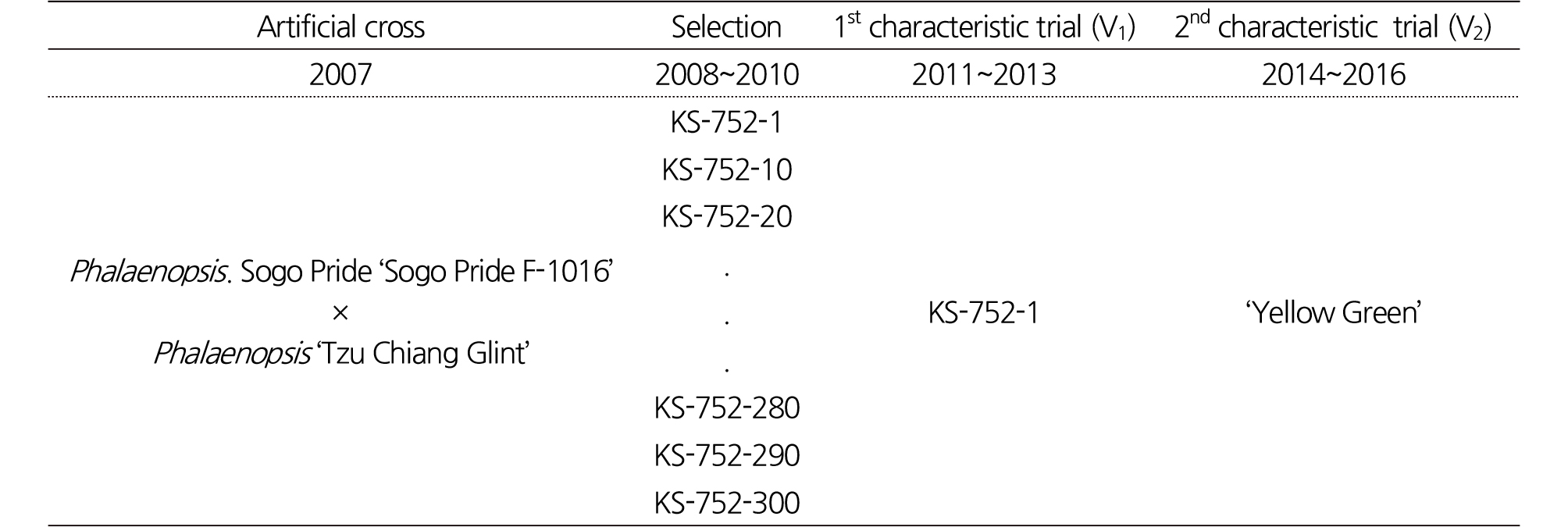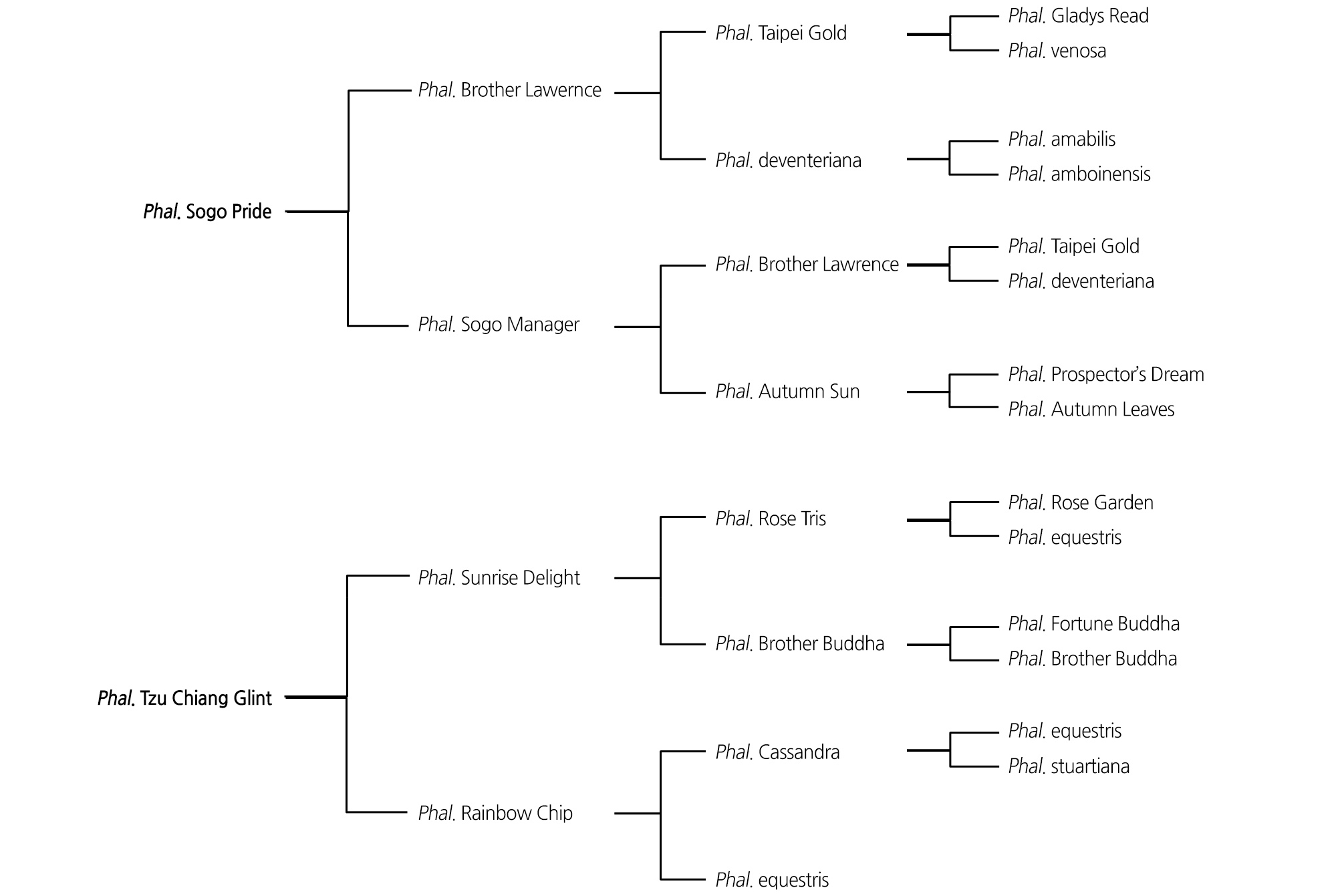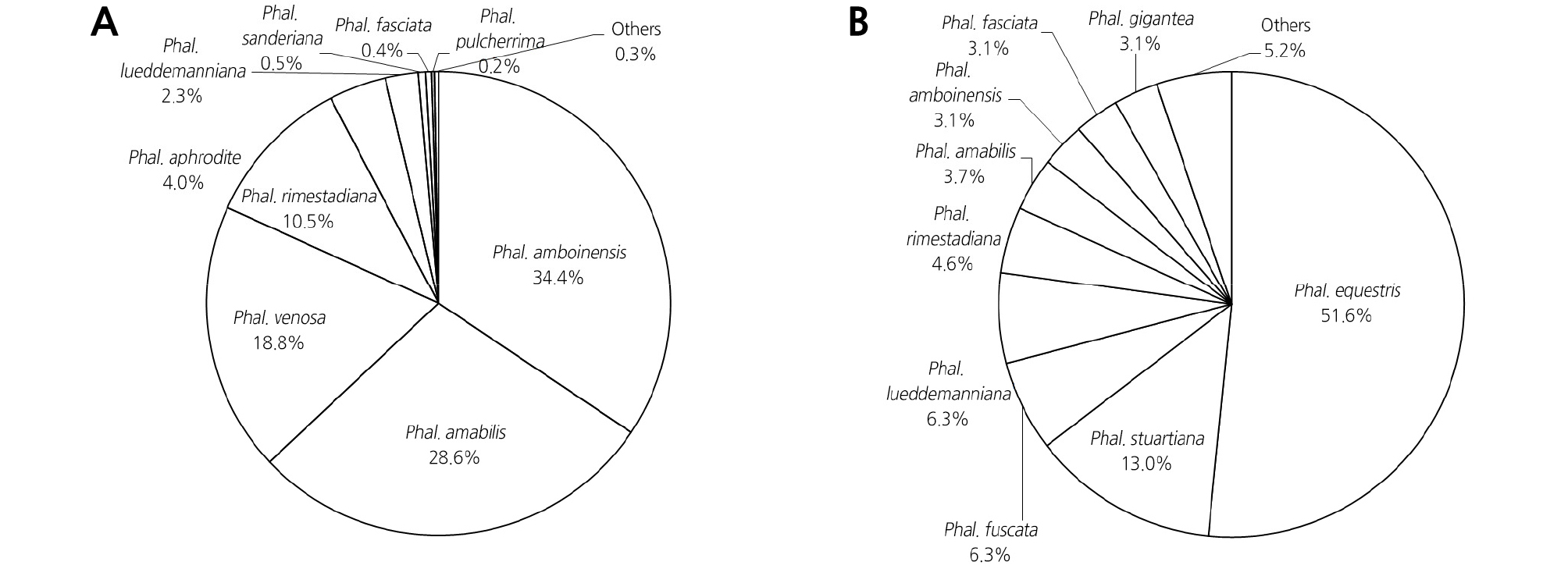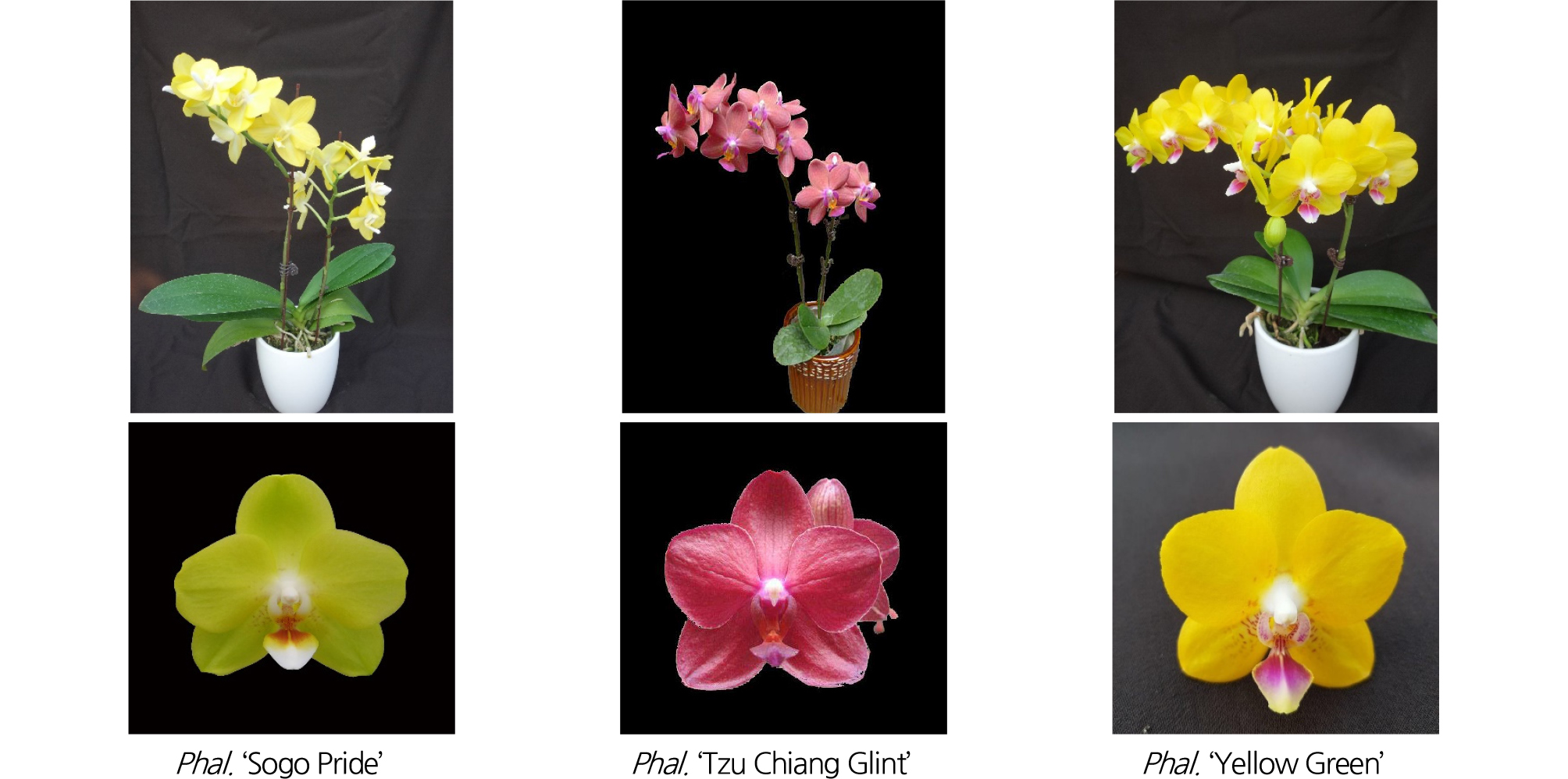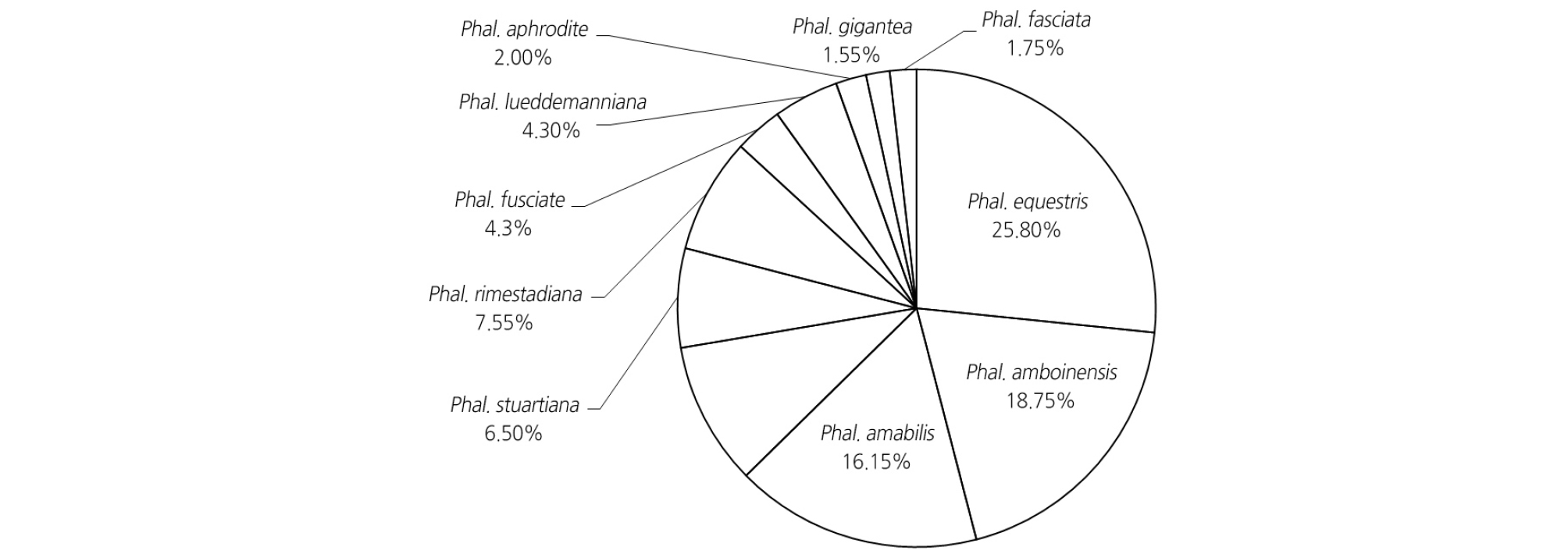Introduction
Phalaenopsis cultivars include interspecific hybrids as well as intergeneric hybrids between the orchid genera Doritisand Phalaenopsis (Dor x Phal), and new Phalaenopsis varieties are being continuously developed by the horticulture industry (Pablo, 2008). The importance of Phalaenopsis orchids to the horticultural industry has raised the issue of how to protect the variety rights or intellectual property rights of new plants (variety, cultivar, or hybrid), as it is easy to reproduce an orchid plant by clonal propagation based on tissue culture (Kwon et al., 2018). However, long-term in vitro propagation of plants results in somaclonal variation, which impedes the creation of true to type plants during clonal propagation. Thus, early detection of somaclonal variants is essential for growers to minimize economical loss (Lee et al., 2017). Large hybrid cultivars of Phalaenopsis are not easy to cultivate because the varieties are not genetically uniform. However, clonal varieties have been developed and popularized, making high-quality production easier (Ichihashi and Mii, 2006). Moreover, flowering and shipping can be easily controlled by temperature management. Since Phalaenopsis also has a variety of flower shapes, colors, and a long coronary period, their demand is continuously increasing. In 2016, the total cultivated area was 40 ha and total production was valued at 20,028 million Korean won (MAFRA, 2017). However, most of the current cultivars are made in Taiwan and the payment of royalties is becoming a burden. Moreover, flavonoid formation was found to be favored in PLB-derived plantlets under all lighting system (Kwon et al., 2018) and in Phalaenopsis Blume, interspecific and intergeneric hybridization has long been used for breeding superior hybrids (Bolanos-Villegas et al., 2008).
Furthermore, almost all Phalaenopsis grown in Korea and about 60% of those in China are red in color and it is expected that these countries will develop many varieties of other colors to satisfy the increasing demand. Air humidity is an important environmental factor for growth and photosynthesis in the cultivation of horticultural crops. However, humidity is often regarded as a minor factor compared to temperature or light (Lee et al., 2018). Several colors of Phalaenopsis were reported in Korea including ten varieties of the red line (Lee et al., 2006a; Joung et al., 2010; Kim et al., 2011; Yae et al., 2012; Hwang et al., 2015; Lim et al., 2015, Lim et al., 2016a, Lim et al., 2016b, Lim et al., 2018; Park et al., 2015; Kwon et al., 2017), two varieties of the purple line (Park et al., 2009; Hwang et al., 2014), six varieties of the white line (Been et al., 2007; Been et al., 2008; Joung et al., 2011; Yea et al., 2014), and four varieties of the yellow line (Lee et al., 2007; Kim et al., 2009; Been et al., 2011; Kim et al., 2017). While there are some differences in the actual numbers, about 98 varieties were reported in publications and are registered with the Korean Seed & Variety Service (KSVS, 2019), but yellow lines are rare.
Phalaenopsis reported in Korea are categorized as six large varieties (Been et al., 2007; Park et al., 2009; Been et al., 2011; Hwang et al., 2015; Lim et al., 2015; Lim et al., 2016b), seven medium varieties (Lee et al., 2006b, Lee et al., 2007; Kim et al., 2007; Joung et al., 2010; Kim et al., 2011; Yae et al., 2012, Yae et al., 2014), and nine small varieties (Lee et al., 2006a; Been et al., 2008; Kim et al., 2009; Joung et al., 2011; Hwang et al., 2014; Park et al., 2015; Lim et al., 2016a; Kim et al., 2017; Lim et al., 2018); thus, there are more medium and large varieties than small varieties.
The aim of this study was to explore means of replacing imported seed and opening up the Chinese market by cultivating Phalaenopsis ‘Yellow Green’, which is well adapted to the domestic environment, easy to grow, and produces small, yellowish flowers favored in the domestic and overseas markets.
Materials and Methods
Plant Materials
The pedigree diagram of the new Phalaenopsis cultivar ‘Yellow Green’ (KS-752-1) is shown in Fig. 1. ‘Yellow Green’ was bred at Kangsan Orchids, Korea. The new cultivar, having small, deep-yellow flowers with a red lip, was introduced by artificial crossing of the Phalaenopsis cultivar ‘Sogo Pride F-1016’ and the Phalaenopsis cultivar ‘Tzu Ching Glint’ in January, 2017.
The family tree (Fig. 2) and the genetic composition of the parents of ‘Yellow Green’ (Fig. 3) used in this experiment were investigated using the OrchidWiz Encyclopedia program (OrchidWiz Orchid database software, version 11.0). The genetic composition of ‘Yellow Green’ (Fig. 5) was calculated based on the genetic composition of the parents (Fig. 3). Due to presence of different genome in both parents, it was made average in F1 while the genome present in its male and female parent was divided by 2.
Cultivation Methods
After artificial crossing for six months, the ripe pods were disinfected and then sown onto the culture medium for Phalaenopsis (Hyponex 3 g·L-1, peptone 4 g·L-1, sucrose 30 g·L-1). The germinated seedlings were grown in vitro, and seedlings with poor growth, such as leaf deformities, were removed, and fast growing, healthy seedlings were selected. In April 2008, 300 seedlings with excellent vegetative growth characteristics were selected and cultivated in vitro in the greenhouse. In 2010, KS-752-1 individuals with excellent vegetative growth characteristics, strong disease tolerance, and bovine flowers with bright-yellow color were selected from among the flowering individuals (Fig. 1). Selected individuals were used for tissue culture. In 2011 and 2014, the first- and second-generation growth characteristics were observed over two years, and the stability and uniformity of the varieties were confirmed. The final varieties were registered under the cultivar name of ‘Yellow Green’. The female parent Phalaenopsis ‘Sogo Pride F-1016’ with small, yellow-colored flowers, similar to ‘Yellow Green’, was used as the female control cultivar to measure the characteristics of growth and flowering. In 2014 and 2015, extending over two generations, the characteristics of growth and flowering were investigated according to protocols described in the manual for agricultural investigation of the Rural Development Administration (RDA, 2003) and the examination procedure recommended by the Korea Seed & Variety Service (KSVS, 2004). The reproductive rate was expressed as the percentage of protocorm-like bodies (PLB) occurring in the leaf culture and the low temperature treatment for flowering was maintained at 25/18°C (day/night).
Results and Discussion
The family tree of the parents of ‘Yellow Green’ is shown in Fig. 2. The female parent ‘Sogo Pride’ was a cross of Phalaenopsis ‘Brother Lawrence’ and Phalaenopsis ‘Sogo Manager’, and was registered with the Royal Horticultural Society (RHS) in 2000. The male Phalaenopsis ‘Tzu Chiang Glint’ was a cross of Phalaenopsis ‘Sunrise Delight’ and Phalaenopsis ‘Rainbow Chip’ and registered with the RHS in 2001.
The genetic composition of the parents of ‘Yellow Green’ is shown in Fig. 3. The female parent ‘Sogo Pride’ showed an ancestry with P.amboinensis contributing the highest proportion at 34.4%, followed by P. amabilis, 28.6%; P.venosa, 18.8%; P. rismestadiana, 10.5%; P. aphrodite, 4.0%; P. lueddemanniana, 2.3%; P. sanderiana, 0.5%; P. fasciata, 0.4%; P. pulcherrima, 0.2%; and others 0.3%. The male parent Phalaenopsis ‘Tzu Chiang Glint’ had an ancestry of P. equestris contributing the highest proportion at 51.6%, followed by P. stuartiana, 13%; P. lueddemanniana and P. fuscata, 6.3%; P. rimestadiana, 4.6%; P. amabilis, 3.7%; P. amboinensis, P. fasciata, and P. gigantea, 3.1%; and others 5.2%.
The flower characteristics of the parents is shown in Fig. 4. The female parent ‘Sogo Pride’ has a yellow flower with a white lip, which is small and almost round. The flower of the male parent ‘Tzu Chiang Glint’ is small, dark-red with a lip of the same color, and completely round. ‘Yellow Green’ has flowers of a darker and clearer yellow color (RHS #: 5A) than that of ‘Sogo Pride’, while the lip has a red color (RHS #: n74A) similar to the male parent (Table 1 and Fig. 4). The shape of the flower is similar to that of the female parent ‘Sogo Pride’ with a small, round, and concave type and the plant produces fewer flowers than the female parent. ‘Yellow Green’ has a better flower appearance than that of the female parent (Fig. 4). The flower color of ‘Sogo Pride’ is light-yellow, whereas ‘Yellow Green’ is bright and warm (Table 1 and Fig. 4). The flowers of ‘Yellow Green’ start as a light-green color at the beginning of flowering, and then gradually turn to deep-yellow. The length and width of the flowers are 4.6 and 4.9 cm, respectively, which is slightly smaller (5.6 and 6.4 cm, respectively) than that of the control. The inflorescence length of ‘Yellow Green’ is 13.0 cm longer than that of the control variety and ‘Yellow Green’ produces two more flowers than the control variety (9 vs. 7, respectively) (Table 1 and Fig. 4). In addition, the flowers of ‘Yellow Green’ have a bilaterally symmetrical arrangement, and it was judged that the overall appearance was harmonious and balanced. The length and width of the leaf is 17.5 and 6.2 cm, respectively, which is similar to that of the control variety (20.0 and 5.9 cm, respectively) but the leaf length of ‘Yellow Green’ is much shorter. Leaf attitude is horizontal, leaf type is narrow ovate, and leaf color is green (Table 2). ‘Yellow Green’ was an artificial cross between the female parent Phalaenopsis ‘Sogo Pride’ and the male parent Phalaenopsis. ‘Tzu Chiang Glint’. The genetic composition was calculated and is shown in Fig. 3. The proportion of P. equestris was 25.8%, followed by P. amboinensis, 18.75%; P. amabilis, 16.15%; P. venosa, 9.4%; P. rimestadiana, 7.55%; P. stuartiana, 6.5%; P. lueddemanniana, 4.3%; P. aphrodite, 2%; P. gigantea, 1.55%; P. fusciate, 1.75%; others 3.1% (Fig. 5).
Table 1. Flower characteristics of the new Phalaenopsis cultivar 'Yellow Green'
Table 2. Leaf characteristics of the new Phalaenopsis cultivar 'Yellow Green'
‘Yellow Green’ was monitored for its growth characteristics over a period of seven years and individuals were selected with robust growth and the ability to be resilient in the summer. Therefore, its cultivation and quality management, which are important horticultural characteristics, are very easy. In particular, because the inflorescence is somewhat short, induction and transportation of the pedicle is easier (Table 1 and Fig. 4). These characteristics are needed to develop a new market for Phalaenopsis in the future. Flowering in Phalaenopsis is generally induced at a temperature of 25°C or lower, with differences between species (Ichihashi and Mii, 2006). If the flowering induction period is long, the maintenance required at specific temperatures results in higher air conditioning costs and consequently a higher unit price. The low temperature treatment period required to induce flowering of ‘Yellow Green’ is 87.3 days, which is similar to the 83.9 days of the control variety (Table 3).
Table 3. Other characteristics of the new Phalaenopsis cultivar 'Yellow Green'
‘Yellow Green’ has vigorous vegetative growth and the plant is robust. Therefore, cultivation management is easier considering the general cultivation environment required for the species. The required culture conditions are 25°C, 70% humidity, and a light intensity of about 270 µmol·m-2·s-1. However, at the flowering stage, the development of flower color is unstable at low and extremely high temperatures. Therefore, to produce desirable flowers, ‘Yellow Green’ should be cultivated at 20°C with a light intensity of 700-800 µmol·m-2·s-1 during differentiation and development. Currently, Phalaenopsis cultivar is almost clone, and the ability to reliably induce PLB and its growth characteristics in mass production is a very important factor in the profitability and sustainability of these varieties (Been, 2003). The characteristics of ‘Yellow Green’ through the second generation of vegetative reproduction are excellent in mass productivity, have uniform plant height and degree of flowering, and no mutation occurs during cultivation (Table 3 and Fig. 4).
The application for breeding protection (application number 2015-413) under the Seed Industry Act for the new variety ‘Yellow Green’ was submitted on June 11, 2015, tested for breeding on July 18, 2016 (Registration No. 6268), and received breed protection from July 18, 2016 to July 17, 2036. It is currently cultivated and shipped by Kangsan Orchids located in 55-38, Daejeojungang-ro 71beon-gil, Gangseo-gu, Busan, Republic of Korea.


